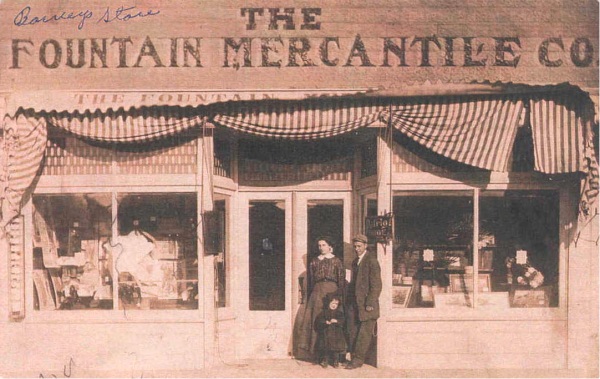FOUNTAIN HISTORY

FOUNDED 1859
The town of Fountain was founded in 1859, the same year as Colorado City, Denver, Golden and Central City. It was built with the idea it would someday be the biggest city in the state, possibly the state capitol. Even then the town had big ideas!
Fountain can trace its roots to the Ute Indians choosing the confluence of Jimmy Camp Creek and Fountain Creek as wintering grounds. Rich with game, trappers followed setting up trading posts along the Fountaine Qui Bouille or "bubbling springs."
TRAPPERS AND TRADERS
There are many stories about Jimmy's Camp, a trading post said to connect the forts on the plains to forts on the front range of the Rockies. Some say Jimmy was an Irishman, some say a soldier, and others say a trader. His camp laid along the creek on "Trappers Trail," Cherokee Trail," or "Jimmy's Camp Trail," depending on whose version is told. All agree Jimmy was killed in his camp around 1842. Every tale tells a different version of "who dun it!"
PONY EXPRESS
Fountain is said to have had a Pony Express stop at one of its first houses, which doubled as a post office. Mail later came by rail. The post office moved to Barney's Food Market on Main Street in 1926. The first post office in El Paso County was in Fountain Valley. Fountain's post office remains the oldest one in the County.
STAGECOACH ROUTE
A stagecoach road connected Canyon City and Denver in 1873. The Colorado gold rush increased its patronage. Coaches ran day and night, stopping only to switch horses or allow buffalo herds to pass...our first traffic jams! Stagecoaches eventually gave way to rail.
DEEP ROOTS IN RANCHING
Settlers arrived in covered wagons, farms sprung up and soon the valley was alive with cattle, dairies and merchants. The main crops were sugar beets, cherries, beans, grain, corn and alfalfa. In 1919 the town was still surrounded by farms, and the irrigation ditches still flow today.
In 1898 the Fountain Trading Company was established and still stands today at 117 Main Street. This mercantile store provided supplies to miners, traders, ranchers, trappers and farmers. The oldest church in El Paso County is just two blocks north.
THE BIG BLAST!!!
But the big idea went up in smoke, quite literally, in 1888 when a train broke loose in Colorado Springs, gained speed approaching Fountain and slammed into a rail car, starting a fire. The fire spread to a car full of explosives. The blast was felt 13 miles north in Colorado Springs. Residents of Monument, 33 miles to the north, reported it woke almost everyone in town!
Fountain rebuilt itself and was incorporated as a town in 1903. It remains one of the oldest incorporated towns in the Pikes Peak region.
By 1942 the war had arrived, and Fountain had a new neighbor. Named after Kit Carson, Fort Carson was founded in 1942 and has played a major role in the community. Between 1942 and 1956, trains of up to 300 mules were a common sight to carry equipment, weapons and supplies over mountainous terrain. For 13 years, the mule Hambone carried supplies for Fort Carson and was buried with full military honors. Today "the Mountain Post" has over 25,000 soldiers.
ALL AMERICA CITY
“There are three wonderful reasons why I love Fountain… the kind people, wonderful schools, and the beautiful environment.” Amanda Kochevar, 2002, 5th Grade Essay Contest Winner “Why I Like Living in Fountain.”
In 2002, Fountain was one of 10 cities to receive recognition as an “All-America” City in Kansas City, Missouri, from the Denver-based National Civic League. The awards competition recognizes communities for citizen involvement and civic excellence.
In 2002 Fountain had just over 15,000 residents and was Colorado’s 10th community to receive the award since it was created in 1949. Approximately 45 representatives of Fountain attended the ceremony.
The achievements the city touted during the competition included:
Developing a community center: Fountain utilized an abandoned school to open the Lorraine Education and Community Center, with more than 16 non-profit organizations collaborating to provide community services.
Planning the future of the city from land use to recreational to environmental needs: the city developed two new “green-frastructure” parks: Hibbard Park and John Lindamood Park; built a new municipal complex and plaza as well as completed $1+ million in streetscape - sidewalks, parking and landscaped medians.
Improving School District 8’s performance, including higher test scores and a 98 percent high school graduation rate: Fountain improved national test scores; achieved 95% district-wide attendance rate, 93.4% graduation rate with a 92.5% minority graduation rate.
How were these achievements accomplished? A challenge was posed to City Council to develop a series of plans and activities, beginning with the city comprehensive plan -- and including the contributions of schools, businesses, residents, youth and its non-profit community -- to effectively manage urban population growth and economic development, while providing and maintaining a high quality of services to enhance its citizens’ lifestyles and the Fountain Valley community’s image.

In 2008, volunteers started work on a historic walking tour and forming an official historic district registered with the
State Office of Historic Preservation.
VISIT THE FOUNTAIN VALLEY HISTORIC MUSEUM
Located at the corner of Main Street and Iowa in downtown Fountain. Staffed by local volunteers, its hours are Saturdays: 10 a.m. to 3 p.m.